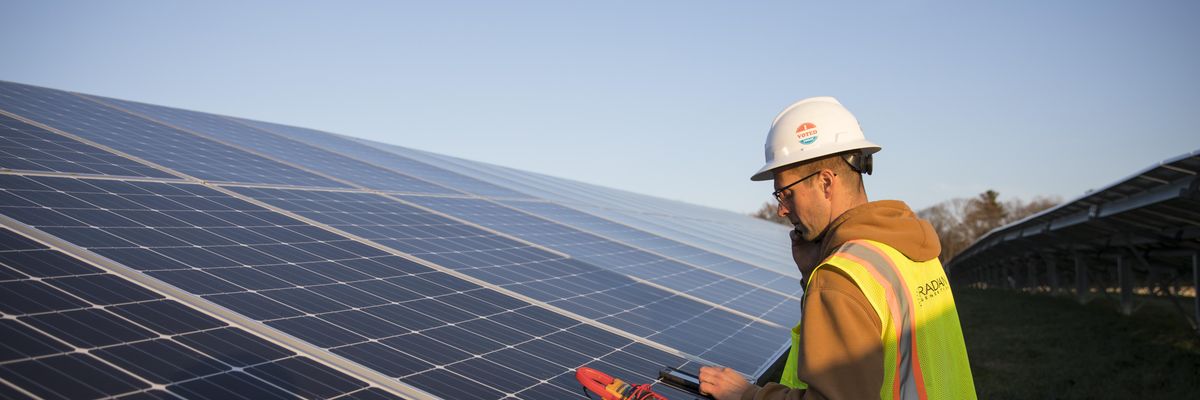
A worker performs maintenance at the BlueWave Community Solar Farm in Grafton, Massachusetts on December 4, 2017. (Photo: Robert Nickelsberg/Getty Images)
Rising US Renewables Expected to Spur Decline in Fracked Gas
"Renewable energy is starting to do to natural gas what natural gas did to coal."
Over the next two years, renewable energy sources are projected to generate a growing share of electricity in the U.S., according to a forecast shared Tuesday by the federal government, which expects a related decrease in production at fossil fuel-fired power plants.
"Most of the growth in U.S. electricity generation in 2022 and 2023 will come from new renewable energy sources."
Based on their analysis of trends in electricity generation, researchers at the U.S. Energy Information Administration (EIA) predict that the share of power produced nationwide by renewable sources--including solar and wind but excluding hydro and nuclear--will increase from 13% in 2021 to 17% in 2023.
Meanwhile, the amount of electricity generated from fracked gas will fall from 37% in 2021 to 34% by 2023, says the EIA, while the proportion coming from coal will decline from 23% to 22% during the same time period.
In response to the report, Sean O'Leary, a senior researcher at the Ohio River Valley Institute--a think tank dedicated to the pursuit of a more egalitarian, democratic, and sustainable Appalachia--suggested that "renewable energy is starting to do to natural gas what natural gas did to coal."
\u201cRenewable energy is starting to do to natural gas what natural gas did to coal. https://t.co/GlNWWIUsCR\u201d— Sean O'Leary (@Sean O'Leary) 1642517474
Notwithstanding last year's boost in coal production, which coincided with a doubling in the cost of fracked gas, the EIA explained that a key shift over the past decade and a half of U.S. electricity generation has been the "steady decline in the use of coal-fired power plants since their peak output in 2007 and the increasing use of natural gas, primarily as a result of sustained low natural gas prices."
"One of the most significant shifts in the mix of U.S. electricity generation over the past 10 years," the agency added, "has been the rapid expansion of renewable energy resources, especially solar and wind. The amount of solar power generating capacity operated by the U.S. electric power sector at the end of 2021 is 20 times more than it was at the end of 2011, and U.S. wind power capacity is more than twice what it was 10 years ago."
Related Content

'A Remarkable Story of Resilience and Hope': Renewable Energy Smashes Records in 2020
According to the EIA's current short-term energy outlook, "most of the growth in U.S. electricity generation in 2022 and 2023 will come from new renewable energy sources"--reducing the need for production at fossil fuel-fired power plants.
The agency explained:
We estimate that the electric power sector had 63 gigawatts (GW) of existing solar power generating capacity operating at the end of 2021. We forecast solar capacity will grow by about 21 GW in 2022 and by 25 GW in 2023. We expect that seven GW of wind generating capacity will be added in 2022 and another four GW in 2023. Operating wind capacity totaled 135 GW at the end of 2021.
Our forecast of growth in renewable electricity generation over the next two years leads to our forecast of a reduced need for fossil-fueled generation. Although we expect natural gas prices for electric generators to decline, the operating costs of renewable generators will continue to be generally lower than natural gas-fired units. We expect that regions of the country with the largest increases in renewable capacity, such as Texas and the Midwest/Central regions, will experience the largest reductions in natural gas generation.
As Justin Jacobs, a Houston correspondent at the Financial Times covering the political economy of energy, noted on Twitter: The EIA's latest forecast predicts that by the end of 2023, nearly half of U.S. electricity generation will come from "zero-emission power," meaning solar, wind, hydro, and nuclear.
\u201cInteresting from the EIA on wind and solar starting to eat into natural gas' market share. This forecast has zero-emission power (nukes+wind+solar+hydro) pretty close to a 50-50 mix with gas and coal by 2023 https://t.co/ujyx25ITHR\u201d— Justin Jacobs (@Justin Jacobs) 1642524647
While a decrease in fracked gas and coal production in the U.S. would be a step in the right direction toward addressing the fossil fuel-driven climate emergency, experts say the scale and pace of the transition to clean energy still needs to increase to avoid catastrophic levels of global warming.
Despite climate scientists' repeated warnings about the need to keep coal, oil, and gas in the ground to have a fighting chance of limiting global temperature rise to 1.5oC above preindustrial levels by the end of the century, fossil fuel corporations are currently planning to expand extraction in wealthy and impoverished nations alike.
Though the Big Oil lobby argues that decarbonization will leave millions of workers unemployed, advocates for a just transition have always emphasized that the shift to a post-carbon economy should be treated as an opportunity to create good-paying jobs that simultaneously reduce greenhouse gas pollution and inequality.
A study published last year found that shifting from fossil fuels to renewables would add eight million jobs worldwide, boosting overall employment in the energy sector by more than 40% by 2050. Another recent study confirmed that green public spending yields far more jobs than unsustainable investments.
According to the Paris-based International Energy Agency (IEA), "To reach net-zero emissions by 2050, annual clean energy investment worldwide will need to more than triple by 2030 to around $4 trillion."
Doing so would "create millions of new jobs," said the IEA, and there's plenty of work to be done. Quadrupling global solar power by 2030, for instance, "is equivalent to installing the world's current largest solar park roughly every day" for the rest of this decade.
An Urgent Message From Our Co-Founder
Dear Common Dreams reader, The U.S. is on a fast track to authoritarianism like nothing I've ever seen. Meanwhile, corporate news outlets are utterly capitulating to Trump, twisting their coverage to avoid drawing his ire while lining up to stuff cash in his pockets. That's why I believe that Common Dreams is doing the best and most consequential reporting that we've ever done. Our small but mighty team is a progressive reporting powerhouse, covering the news every day that the corporate media never will. Our mission has always been simple: To inform. To inspire. And to ignite change for the common good. Now here's the key piece that I want all our readers to understand: None of this would be possible without your financial support. That's not just some fundraising cliche. It's the absolute and literal truth. We don't accept corporate advertising and never will. We don't have a paywall because we don't think people should be blocked from critical news based on their ability to pay. Everything we do is funded by the donations of readers like you. Will you donate now to help power the nonprofit, independent reporting of Common Dreams? Thank you for being a vital member of our community. Together, we can keep independent journalism alive when it’s needed most. - Craig Brown, Co-founder |
Over the next two years, renewable energy sources are projected to generate a growing share of electricity in the U.S., according to a forecast shared Tuesday by the federal government, which expects a related decrease in production at fossil fuel-fired power plants.
"Most of the growth in U.S. electricity generation in 2022 and 2023 will come from new renewable energy sources."
Based on their analysis of trends in electricity generation, researchers at the U.S. Energy Information Administration (EIA) predict that the share of power produced nationwide by renewable sources--including solar and wind but excluding hydro and nuclear--will increase from 13% in 2021 to 17% in 2023.
Meanwhile, the amount of electricity generated from fracked gas will fall from 37% in 2021 to 34% by 2023, says the EIA, while the proportion coming from coal will decline from 23% to 22% during the same time period.
In response to the report, Sean O'Leary, a senior researcher at the Ohio River Valley Institute--a think tank dedicated to the pursuit of a more egalitarian, democratic, and sustainable Appalachia--suggested that "renewable energy is starting to do to natural gas what natural gas did to coal."
\u201cRenewable energy is starting to do to natural gas what natural gas did to coal. https://t.co/GlNWWIUsCR\u201d— Sean O'Leary (@Sean O'Leary) 1642517474
Notwithstanding last year's boost in coal production, which coincided with a doubling in the cost of fracked gas, the EIA explained that a key shift over the past decade and a half of U.S. electricity generation has been the "steady decline in the use of coal-fired power plants since their peak output in 2007 and the increasing use of natural gas, primarily as a result of sustained low natural gas prices."
"One of the most significant shifts in the mix of U.S. electricity generation over the past 10 years," the agency added, "has been the rapid expansion of renewable energy resources, especially solar and wind. The amount of solar power generating capacity operated by the U.S. electric power sector at the end of 2021 is 20 times more than it was at the end of 2011, and U.S. wind power capacity is more than twice what it was 10 years ago."
Related Content

'A Remarkable Story of Resilience and Hope': Renewable Energy Smashes Records in 2020
According to the EIA's current short-term energy outlook, "most of the growth in U.S. electricity generation in 2022 and 2023 will come from new renewable energy sources"--reducing the need for production at fossil fuel-fired power plants.
The agency explained:
We estimate that the electric power sector had 63 gigawatts (GW) of existing solar power generating capacity operating at the end of 2021. We forecast solar capacity will grow by about 21 GW in 2022 and by 25 GW in 2023. We expect that seven GW of wind generating capacity will be added in 2022 and another four GW in 2023. Operating wind capacity totaled 135 GW at the end of 2021.
Our forecast of growth in renewable electricity generation over the next two years leads to our forecast of a reduced need for fossil-fueled generation. Although we expect natural gas prices for electric generators to decline, the operating costs of renewable generators will continue to be generally lower than natural gas-fired units. We expect that regions of the country with the largest increases in renewable capacity, such as Texas and the Midwest/Central regions, will experience the largest reductions in natural gas generation.
As Justin Jacobs, a Houston correspondent at the Financial Times covering the political economy of energy, noted on Twitter: The EIA's latest forecast predicts that by the end of 2023, nearly half of U.S. electricity generation will come from "zero-emission power," meaning solar, wind, hydro, and nuclear.
\u201cInteresting from the EIA on wind and solar starting to eat into natural gas' market share. This forecast has zero-emission power (nukes+wind+solar+hydro) pretty close to a 50-50 mix with gas and coal by 2023 https://t.co/ujyx25ITHR\u201d— Justin Jacobs (@Justin Jacobs) 1642524647
While a decrease in fracked gas and coal production in the U.S. would be a step in the right direction toward addressing the fossil fuel-driven climate emergency, experts say the scale and pace of the transition to clean energy still needs to increase to avoid catastrophic levels of global warming.
Despite climate scientists' repeated warnings about the need to keep coal, oil, and gas in the ground to have a fighting chance of limiting global temperature rise to 1.5oC above preindustrial levels by the end of the century, fossil fuel corporations are currently planning to expand extraction in wealthy and impoverished nations alike.
Though the Big Oil lobby argues that decarbonization will leave millions of workers unemployed, advocates for a just transition have always emphasized that the shift to a post-carbon economy should be treated as an opportunity to create good-paying jobs that simultaneously reduce greenhouse gas pollution and inequality.
A study published last year found that shifting from fossil fuels to renewables would add eight million jobs worldwide, boosting overall employment in the energy sector by more than 40% by 2050. Another recent study confirmed that green public spending yields far more jobs than unsustainable investments.
According to the Paris-based International Energy Agency (IEA), "To reach net-zero emissions by 2050, annual clean energy investment worldwide will need to more than triple by 2030 to around $4 trillion."
Doing so would "create millions of new jobs," said the IEA, and there's plenty of work to be done. Quadrupling global solar power by 2030, for instance, "is equivalent to installing the world's current largest solar park roughly every day" for the rest of this decade.
Over the next two years, renewable energy sources are projected to generate a growing share of electricity in the U.S., according to a forecast shared Tuesday by the federal government, which expects a related decrease in production at fossil fuel-fired power plants.
"Most of the growth in U.S. electricity generation in 2022 and 2023 will come from new renewable energy sources."
Based on their analysis of trends in electricity generation, researchers at the U.S. Energy Information Administration (EIA) predict that the share of power produced nationwide by renewable sources--including solar and wind but excluding hydro and nuclear--will increase from 13% in 2021 to 17% in 2023.
Meanwhile, the amount of electricity generated from fracked gas will fall from 37% in 2021 to 34% by 2023, says the EIA, while the proportion coming from coal will decline from 23% to 22% during the same time period.
In response to the report, Sean O'Leary, a senior researcher at the Ohio River Valley Institute--a think tank dedicated to the pursuit of a more egalitarian, democratic, and sustainable Appalachia--suggested that "renewable energy is starting to do to natural gas what natural gas did to coal."
\u201cRenewable energy is starting to do to natural gas what natural gas did to coal. https://t.co/GlNWWIUsCR\u201d— Sean O'Leary (@Sean O'Leary) 1642517474
Notwithstanding last year's boost in coal production, which coincided with a doubling in the cost of fracked gas, the EIA explained that a key shift over the past decade and a half of U.S. electricity generation has been the "steady decline in the use of coal-fired power plants since their peak output in 2007 and the increasing use of natural gas, primarily as a result of sustained low natural gas prices."
"One of the most significant shifts in the mix of U.S. electricity generation over the past 10 years," the agency added, "has been the rapid expansion of renewable energy resources, especially solar and wind. The amount of solar power generating capacity operated by the U.S. electric power sector at the end of 2021 is 20 times more than it was at the end of 2011, and U.S. wind power capacity is more than twice what it was 10 years ago."
Related Content

'A Remarkable Story of Resilience and Hope': Renewable Energy Smashes Records in 2020
According to the EIA's current short-term energy outlook, "most of the growth in U.S. electricity generation in 2022 and 2023 will come from new renewable energy sources"--reducing the need for production at fossil fuel-fired power plants.
The agency explained:
We estimate that the electric power sector had 63 gigawatts (GW) of existing solar power generating capacity operating at the end of 2021. We forecast solar capacity will grow by about 21 GW in 2022 and by 25 GW in 2023. We expect that seven GW of wind generating capacity will be added in 2022 and another four GW in 2023. Operating wind capacity totaled 135 GW at the end of 2021.
Our forecast of growth in renewable electricity generation over the next two years leads to our forecast of a reduced need for fossil-fueled generation. Although we expect natural gas prices for electric generators to decline, the operating costs of renewable generators will continue to be generally lower than natural gas-fired units. We expect that regions of the country with the largest increases in renewable capacity, such as Texas and the Midwest/Central regions, will experience the largest reductions in natural gas generation.
As Justin Jacobs, a Houston correspondent at the Financial Times covering the political economy of energy, noted on Twitter: The EIA's latest forecast predicts that by the end of 2023, nearly half of U.S. electricity generation will come from "zero-emission power," meaning solar, wind, hydro, and nuclear.
\u201cInteresting from the EIA on wind and solar starting to eat into natural gas' market share. This forecast has zero-emission power (nukes+wind+solar+hydro) pretty close to a 50-50 mix with gas and coal by 2023 https://t.co/ujyx25ITHR\u201d— Justin Jacobs (@Justin Jacobs) 1642524647
While a decrease in fracked gas and coal production in the U.S. would be a step in the right direction toward addressing the fossil fuel-driven climate emergency, experts say the scale and pace of the transition to clean energy still needs to increase to avoid catastrophic levels of global warming.
Despite climate scientists' repeated warnings about the need to keep coal, oil, and gas in the ground to have a fighting chance of limiting global temperature rise to 1.5oC above preindustrial levels by the end of the century, fossil fuel corporations are currently planning to expand extraction in wealthy and impoverished nations alike.
Though the Big Oil lobby argues that decarbonization will leave millions of workers unemployed, advocates for a just transition have always emphasized that the shift to a post-carbon economy should be treated as an opportunity to create good-paying jobs that simultaneously reduce greenhouse gas pollution and inequality.
A study published last year found that shifting from fossil fuels to renewables would add eight million jobs worldwide, boosting overall employment in the energy sector by more than 40% by 2050. Another recent study confirmed that green public spending yields far more jobs than unsustainable investments.
According to the Paris-based International Energy Agency (IEA), "To reach net-zero emissions by 2050, annual clean energy investment worldwide will need to more than triple by 2030 to around $4 trillion."
Doing so would "create millions of new jobs," said the IEA, and there's plenty of work to be done. Quadrupling global solar power by 2030, for instance, "is equivalent to installing the world's current largest solar park roughly every day" for the rest of this decade.

